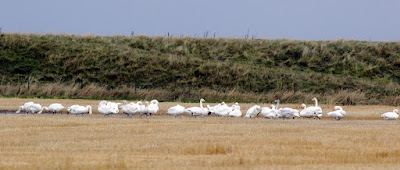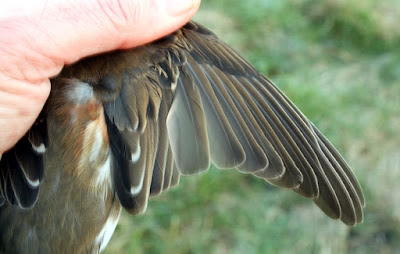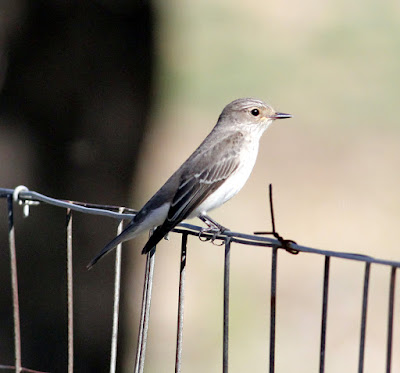After a day of hiding behind the clouds the sun finally emerged at
midday today. For old time’s sake I decided to drive to Out Rawcliffe and take a walk across
Rawcliffe Moss, an ancient peaty landscape which still characterises many parts of Lancashire.
I’ve neglected the moss for a year or more. When the new plantation here became overgrown the use of our previously productive ringing area became impossible without both intensive and costly habitat management. soon after the mixed animal/arable farm was sold and the new owners wasted no time in changing the land use to less crops and more animals. It was a combination that caused a drop in bird life. Birding became more difficult and my visits tailed off.
I’ve neglected the moss for a year or more. When the new plantation here became overgrown the use of our previously productive ringing area became impossible without both intensive and costly habitat management. soon after the mixed animal/arable farm was sold and the new owners wasted no time in changing the land use to less crops and more animals. It was a combination that caused a drop in bird life. Birding became more difficult and my visits tailed off.

Rawcliffe Moss
The moss always was a good place for Little Owls with at least two pairs breeding there in each year where they used the traditional sites of both a building and a line of trees. The farm was quiet today, not many people or vehicles so it didn’t take long to find an owl by looking along familiar fences.
Little Owl
Along the main track of the farm were a good number of Blackbirds but only a single Redwing. The rush of Redwings during past recent weeks is now over without seeing any substantial numbers of their cousin the Fieldfare. I hope to redress the balance by catching some Fieldfares at the weekend with a ringing session in the hills at Oakenclough, the ringing site which has replaced Out Rawcliffe.
Redwing
For my North American readers, a Redwing Turdus iliacus is not closely
related to the Red-winged Blackbird Agelaius phoeniceus, a North American species sometimes
nicknamed 'redwing' which is an icterid, not a thrush. The binomial name Turdus
iliacus derives from the Latin words Turdus, meaning 'Thrush' and 'ile' meaning
flank as in my photograph above.
Today out on the moss I saw four, maybe five Buzzards, some in flight and another sat motionless on a roll of baled hay, a favourite spot for a Buzzard. The rolls are close to the ground should a small mammal wander by or high enough for lift-off should an unwelcome birder wander by. Next in my notebook came a Hen Harrier, a brown female or juvenile “ringtail” floating across the road ahead of me as it hurried across to Pilling Moss. Later as I drove home via Pilling I saw the harrier make the return journey, helped this time by a convoy of corvids that chased it mercilessly until it was off their feeding stubble.
The moss was previously a Tree Sparrow hangout, helped by regular dollops of bird seed to feed sundry species. I struggled to see a Tree Sparrow today eventually coming across three or four in the trees where their nest boxes still dot the trees. A number of Chaffinch were among the sparrows, as well as a few Yellowhammers, but on a return viewing an hour or more later the Chaffinch count had swelled to a miserly 15, Yellowhammers to 2 and Reed Buntings to 5. Not the best farmland bird tally.
Yellowhammer
Next came the big field and a walk over wet stubble where I came across a Merlin, a Kestrel, 2 Corn Bunting, another half-dozen or so Reed Buntings, 5 Linnet, 15 Skylark and 7 Roe Deer. Although the birds scatter along the hedgerow where they might be seen later, Roe Deer never ever stay around but just melt into to the security of a distant wood.
There had been geese landing in fields not far away so as I drove home via the mossland of both Pilling and Stalmine I stopped for a look in the stubble fields. It is very hard to approach the geese for either a photo or close scrutiny.
Pink-footed Geese
Pink-footed Geese
The Pink-footed Geese have been with us for a month or more since leaving Iceland and the closest it is possible to get to them, and by staying in a vehicle, is perhaps 500 yards. On most mornings a number of wildfowlers will lie in wait, hidden in the marshy creeks of Pilling and Cockerham where they hope to intercept the geese with a volley of shots as the birds leave their overnight roost to feed on these inland fields. Boy are these geese wild and who can blame them?
I made my way home after an entertaining and instructive afternoon. Yes it was good to get back on the moss if only for a while.
Linking today to Viewing Nature with Eileen.
I made my way home after an entertaining and instructive afternoon. Yes it was good to get back on the moss if only for a while.
Linking today to Viewing Nature with Eileen.




































































.jpg)












